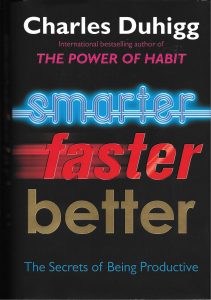The one sentence summary
It is possible to work smarter, faster and better by improving motivation, goals, team dynamics, decision-making, and the assimilation of data.
Can’t be bothered to read it? Listen to the 5-minute summary.
WHAT THE BOOK SAYS 
- This is all about the secrets of being productive. There are eight main reasons why good companies and people get things done:
1. Motivation: make choices that put you in control
2. Teams: manage the how, not the who
3. Focus: envision what will happen and plan for that
4. Goal setting: choose stretching ambitions and break down into sub goals
5. Managing others: push decision making to whoever is closest to problems
6. Decision-making: envision multiple futures to plan ahead
7. Innovation: recombine old and new ideas (90% of the most creative ideas include ideas previously mentioned somewhere else – from a database of 17.9m manuscripts. Innovators are actually intellectual middlemen.)
8. Absorbing data: when encountering new information, force yourself to do something with it. This is best achieved by disfluency – engaging thoroughly with it, which is harder at first. Inability to do so is called information blindness.
- Follow the engineering design process: define the dilemma; collect data; brainstorm solutions; debate approaches; experiment
WHAT’S GOOD ABOUT IT
- The most successful people have an internal locus of control – a belief they can influence their destiny through their choices.
- Cognitive tunnelling causes people to become overly focused on whatever is directly in front of them, rather than what really matters.
- Always ask why you are doing something. If there’s no good reason, don’t.
- People who take notes on laptops generate twice as many notes as those who write things down, but the hand writers score twice as well in subsequent tests because they absorb and remember more.
- A little disturbance is the best way to get creative results – not too much, not too little.
- Teams need to believe that their work is important; to feel their work is personally meaningful; clear goals and defined roles; to know they can depend on each other; and…
- Psychological safety – this is a shared belief that the group is a safe place for taking risks – the opposite of a blame culture.
- Creating mental models helps us predict what might happen and cope better – having a hypothesis about how things work reduces surprises.
- Company cultures fall into 5 categories:
- Star: elite hirings and lots of autonomy
- Engineering: very technical, with few stars
- Bureaucratic: everything spelt out & thick layers of middle management
- Autocratic: similar, but with all goals dictated by the CEO
- Commitment: working happily for one company for life, because the culture is right (these companies are consistently the most successful)
WHAT YOU HAVE TO WATCH
- The interwoven narrative examples are sometimes more akin to a novel than a business book.
- The practical advice at the end is a bit muddled and doesn’t follow the chapter sequence.
